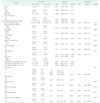Abstract
Purpose
Methods
Results
Figures and Tables
Fig. 1
Study design and population. LDLT, living donor liver transplantation; HCC, hepatocellular carcinoma; LT, liver transplantation; Tx, treatment; TACE, transarterial chemoembolization; CR, complete response; PR, partial response; SD, stable disease; PD, progressive disease; RFA, radiofrequency ablation.

Fig. 2
Disease-free survival (A) and overall survival (B) according to modified response evaluation criteria in solid tumors-defined transarterial chemoembolization (TACE) responses. HR, hazard ratio; CR, complete response; PR, partial response; SD, stable disease; PD, progressive disease.

Fig. 3
Kaplan-Meier analysis of the interval between the last pre-LT TACE and LDLT in all (A), RP (B), and NR (C) patients. The minimum P-value approach indicated the significant cutoff value for interval between last pre-LT TACE and LDLT was 2 months in all patients and the RP group. LT, liver transplantation; TACE, transarterial chemoembolization; LDLT, living donor liver transplantation; RP, responder; NR, nonresponder; DFS, disease-free survival.

Table 1
Clinical, radiological, and pathological characteristics of 134 LDLT recipients who underwent pre-LT TACE

Table 2
Univariate and multivariate cox analysis for HCC recurrence risk factors after LDLT

Values are presented as median (range) or number (%).
HCC, hepatocellular carcinoma; LDLT, living donor liver transplantation; HR, hazard ratio; CI, confidence interval; MELD, model for end-stage liver disease; LT, liver transplantation; TACE, transarterial chemoembolization; RP, responder; NR, nonresponder; NA, not applicable.
*P < 0.05, significant differences.
Table 3
Associations of pre-LT TACE response versus nonresponse with recurrence free survival, cancer specific survival, and overall survival in the subgroups based on the number of TACE or the time from clinically critical time to LDLT

LT, liver transplantation; TACE, transarterial chemoembolization; LDLT, living donor liver transplantation; aHR, adjusted hazard ratio; HCC, hepatocellular carcinoma; Dx,. diagnosis.
*Models were adjusted for largest tumor >3 cm, microvascular invasion, extrahepatic nodal involvement that were independent factors for HCC recurrence after LDLT in multivariate Cox analysis.




 PDF
PDF ePub
ePub Citation
Citation Print
Print



 XML Download
XML Download